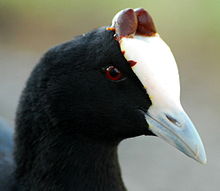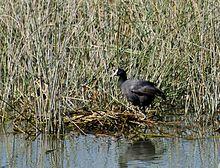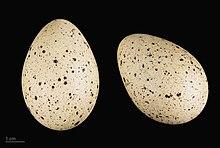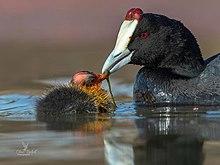| Red-knobbed coot | |
|---|---|
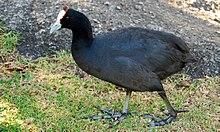 | |
%2c_Fulica_cristata_flying_over_the_water_at_Marievale._(8131770389).jpg) | |
| Adult birds in South Africa | |
| Scientific classification | |
| Kingdom: | Animalia |
| Phylum: | Chordata |
| Class: | Aves |
| Order: | Gruiformes |
| Family: | Rallidae |
| Genus: | Fulica |
| Species: | F. cristata |
| Binomial name | |
| Fulica cristata Gmelin, 1789 | |
The red-knobbed coot or crested coot, (Fulica cristata), is a member of the rail and crake bird family, the Rallidae.
It is a resident breeder across much of Africa and in southernmost Spain on freshwater lakes and ponds. It builds a nest of dead reeds near the water's edge or more commonly afloat, laying about 8 eggs (or more in good conditions).[2] However, its behaviour towards its own young is so aggressive that only a few are likely to survive to adulthood.
Description and identification
_non-breeding.jpg)
The red-knobbed coot is largely black except for the white frontal shield. It is 38–45 cm (15–18 in) long, spans 75–85 cm (30–33 in) across the wings and weighs 585–1,085 g (1.290–2.392 lb).[3][4] As a swimming species, it has partial webbing on its long strong toes. The juvenile is paler than the adult, has a whitish breast, and lacks the facial shield; the adult's black plumage develops when about 3–4 months old, but the white shield is only fully developed at about one year old, some time later.
A good view is necessary to separate this species from the Eurasian coot, with which its range overlaps. There are two tiny red knobs at the top of the facial shield, which are not visible at any great distance and are only present in the breeding season; the black feathering between the shield and the bill is rounded, whereas in Eurasian it comes to a point; and the bill has a bluish grey tinge. In flight, the red-knobbed coot lacks the white trailing edge to the secondaries of the Eurasian coot.
Behaviour
The habits of the red-knobbed coot are practically identical to those of the Eurasian coot. It is much less secretive than most of the rail family. Where it is undisturbed it is likely to bully any intruder, even large birds such as Egyptian geese, if they do not defy its challenges.[2] It can be seen swimming on open water or walking across waterside grasslands. It is an aggressive species, and strongly territorial during the breeding season.
The red-knobbed coot is reluctant to fly and when taking off runs across the water surface with much splashing. It does the same, but without actually flying, when travelling a short distance at speed (to escape a rival, for example, or to dispute possession of a choice morsel). It bobs its head as it swims, and makes short dives from a little jump.
The red-knobbed coot is an omnivore, and will take a variety of small live prey including the eggs of other water birds. Its main food in most waters however comprises various waterweeds such as species of Potamogeton for which it commonly dives.[5]
This is a noisy bird during mating, but its vocalisations are quite different from the Eurasian coot. It gives a fast kerrre like the little crake, a harsh ka-haa and a grunting hoot "oot oot" that suggests that the name "coot" might be onomatopoeia, but inspection of the etymology of "coot" fairly decisively negates any such suggestion.[6]
References
- ^ BirdLife International (2012). "Fulica cristata". IUCN Red List of Threatened Species. 2012. Retrieved 26 November 2013.
- ^ a b Liversidge, Richard. “The birds around us: Birds of the Southern African region” Pub: Fontein 1991 ISBN 978-1-874851-01-1
- ^ CRC Handbook of Avian Body Masses by John B. Dunning Jr. (Editor). CRC Press (1992), ISBN 978-0-8493-4258-5.
- ^ [1] (2011).
- ^ MacLean, Gordon L., Roberts, Austin; “Roberts Birds of Southern Africa”. Pub. Hyperion Books 1988. ISBN 978-1-85368-037-3
- ^ Brown, Lesley; Trumble, William R.; Stevenson, Angus (2002). Shorter Oxford English dictionary on historical principles. Oxford [Oxfordshire]: Oxford University Press. ISBN 0-19-860575-7.
Sources
- Rails by Taylor and van Perlo, ISBN 90-74345-20-4
- Forsman, Dick (1991) Aspects of identification of Crested Coot Dutch Birding 13(4): 121-25
External links
- Red-knobbed coot - Species text in The Atlas of Southern African Birds
- Red-knobbed coot videos, photos & sounds on the Internet Bird Collection

